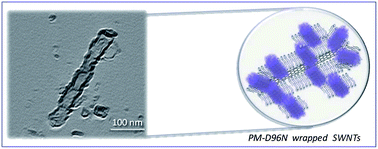Surface chemical functionalization of single walled carbon nanotubes with a bacteriorhodopsin mutant†
Abstract
In this work, single walled

* Corresponding authors
a CNR-IMM, Via per Monteroni, Campus Universitario, Palazzina A3, 73100 Lecce, Italy
b CNR-IPCF sez. Bari, c/o Dip. di Chimica, Università di Bari, via Orabona 4-I, 70126 Bari, Italy
c CNR-IMIP, c/o Dip. di Chimica, Università di Bari, via Orabona 4-I, 70126 Bari, Italy
d Università di Bari Policlinico, Piazza G. Cesare, Bari, Italy
e Dip. di Chimica, Università di Bari, via Orabona 4-I, 70126 Bari, Italy
In this work, single walled

 Please wait while we load your content...
Something went wrong. Try again?
Please wait while we load your content...
Something went wrong. Try again?
C. Ingrosso, G. V. Bianco, P. Lopalco, M. Tamborra, M. L. Curri, A. Corcelli, G. Bruno, A. Agostiano, P. Siciliano and M. Striccoli, Nanoscale, 2012, 4, 6434 DOI: 10.1039/C2NR31999C
To request permission to reproduce material from this article, please go to the Copyright Clearance Center request page.
If you are an author contributing to an RSC publication, you do not need to request permission provided correct acknowledgement is given.
If you are the author of this article, you do not need to request permission to reproduce figures and diagrams provided correct acknowledgement is given. If you want to reproduce the whole article in a third-party publication (excluding your thesis/dissertation for which permission is not required) please go to the Copyright Clearance Center request page.
Read more about how to correctly acknowledge RSC content.
 Fetching data from CrossRef.
Fetching data from CrossRef.
This may take some time to load.
Loading related content
